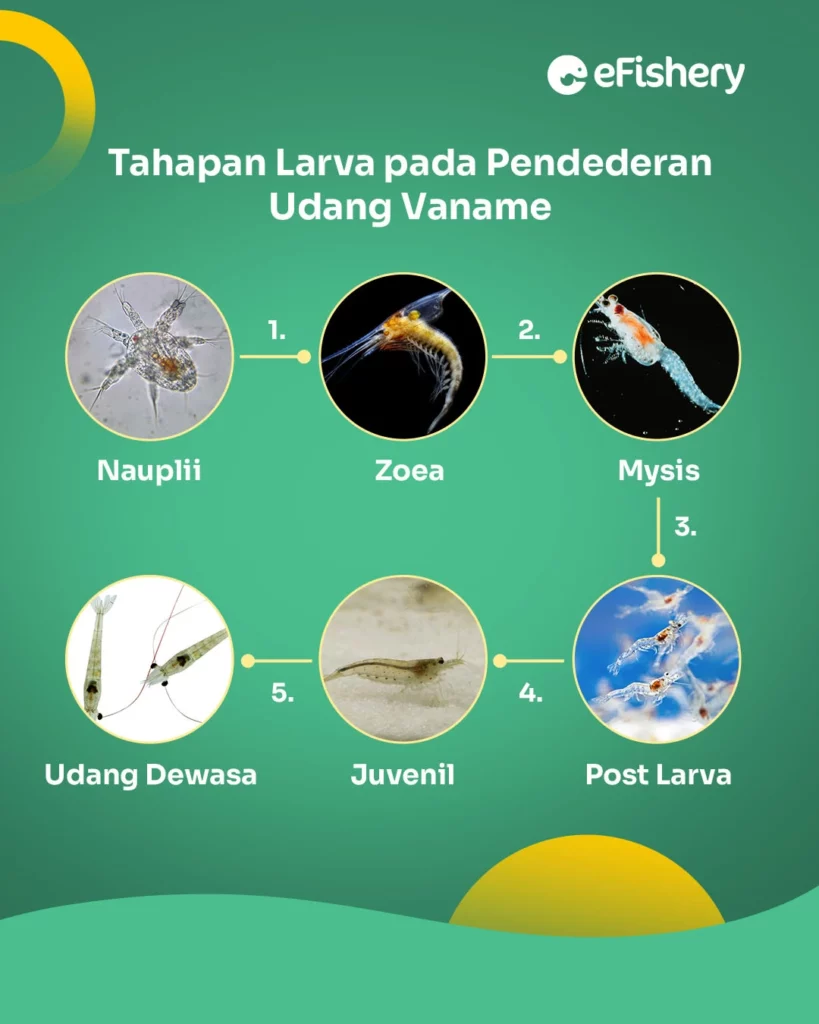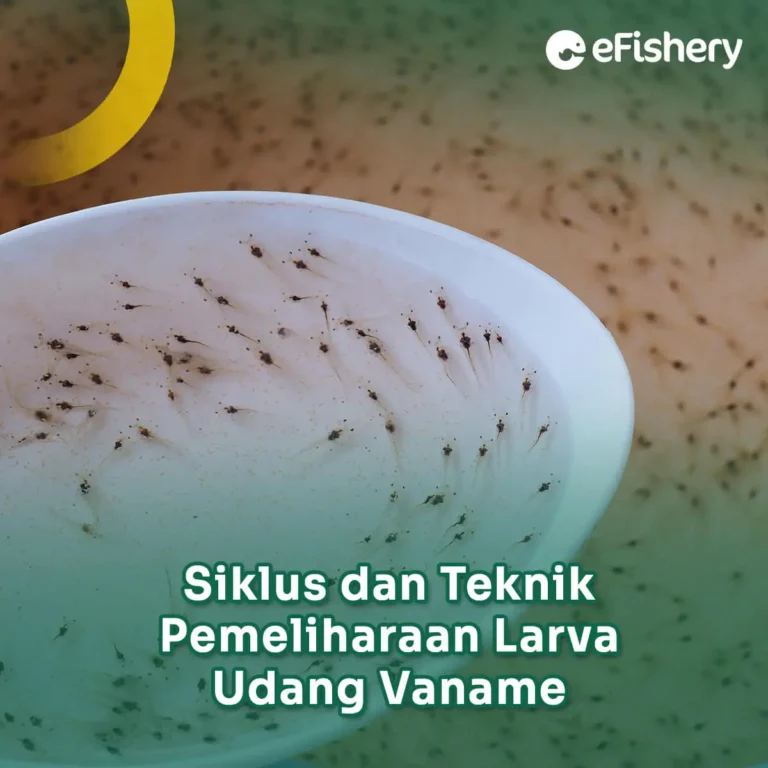Artikel Ini Telah Direview Oleh:

Anggie Nur
Magister Bioteknologi
The maintenance of vannamei shrimp larvae starts from nauplius, zoea, mysis, to post shrimp larvae stages. Until now, vannamei shrimp larvae hatcheries produced by farmers have not fulfilled the existing market demand. The problem lies in the lack of knowledge of novice farmers about shrimp maintenance techniques.
But don't worry, you can easily apply tips on the cycle and techniques for rearing vannamei shrimp larvae. Check out the explanation below!
Vaname Shrimp Larvae Cycle

Vannamei shrimp included crustacean which has 10 legs and a carapace covering the entire head. Vaname shrimp also have nocturnal characteristics, namely looking for food at night. The vaname shrimp fertilization process is marked by the female shrimp jumping suddenly.
In this process, the female shrimp releases egg cells which together with the male shrimp releases sperm, so that the process of fertilization occurs between the egg cells and shrimp sperm. The next stages in the shrimp life cycle after fertilization are the nauplius stage, zoea stage, mysis stage, post larval stage, juvenile stage, young shrimp and adult shrimp. Here's the explanation:
1. Eggs
Vannamei shrimp eggs are thought to sink to the bottom of the pond during spawning. The diameter of the vannamei shrimp eggs is less than 1/64 inch. The number of eggs obtained depends on the size of the parent.
Vaname shrimp brooders weighing 30-45 grams can produce 100,000-250,000 eggs. Eggs will develop into perfect larvae with temperatures between 26-28 ºC, DO 5-7 mg/l, and water salinity of 35 ppt.
2. Nauplius
Nauplius is the stage after the eggs hatch. Shrimp have a body color that tends to be shiny brownish gray. Nauplius have limited swimming ability and are usually part of the oceanic plankton. Nauplius should only be obtained from reputable suppliers with Specific Pathogen Free status or Specific Pathogen Free (SPF) certified for broodstock and the resulting nauplius.
Eggs and nauplius may have come into contact with the female which may be carrying microbial pathogens, so they should be disinfected (process of removing pathogens during transfer to hatchery tanks or larval culture. Nauplius have phototactic properties, which are sensitive to light, so that nauplius tend to gather in one point of light.
3. Zoea
Zoea measures from 1/25 to 1.5 inches. The body shape of the zoea develops in the mouth and stomach so that the larvae begin to actively seek their own food.
4. Mysis
Mysis is planktonic in fresh water which has some body shape morphology that already looks like fan tail development (uropod) and tail (telson).
5. Post Larvae
There are two post larval stages, which are about 1/6 to 1/4 inch in size. At this stage, the larva has the most perfect form compared to the previous stages of metamorphosis. At this stage, the larvae begin to actively move horizontally and vertically in the water column of the shrimp pond.
6. Juvenile
Post larvae shrimp develop directly into juvenile shrimp. Growth in size is fast, up to 2.5 inches per month. At the juvenile stage, juvenile body shape is similar to that of adult shrimp.
7. Young Shrimp
At this stage, the shrimp continues to grow but at a slower rate than in the juvenile phase. Young shrimp usually do not show signs of ovarian maturity (female shrimp) or are not yet suitable for spawning.
Young shrimp under 2 months of age require a salt content of 15-25 ppt for optimal growth. After the age of more than 2 months, it is best to maintain the salt content of the water between 5-30 ppt for the growth of shrimp to the mature shrimp stage.
8. Adult Shrimp
Adult vaname shrimp have a length of 5-8 inches at the age of 1.5 years. Adult shrimp have a complete body shape, such as eyes, cephalothorax, abdomen, legs, tail and antennae. When the spawning season arrives, female adult shrimp marked with brightly colored ovaries flock to the middle of the pond to spawn with male adult shrimp.
3 Vaname Shrimp Larvae Maintenance Techniques
The availability of quality shrimp larvae (genetic and morphological) is an important factor for the success of shrimp farming. Shrimp larvae from nature are only 20% of the total need for shrimp ponds in Indonesia, while the shortage of 80% is expected to produce larvae themselves or by hatchery. Development hatchery increasing in meeting the demand for shrimp larvae for shrimp farming. Check out the vannamei shrimp larvae maintenance technique as follows:
1. Spreading Larvae
The stocking of larvae is carried out in stages, namely selecting larvae seeds that are free from disease. Next is the process of acclimatizing the larvae that are carried using plastic, namely by immersing a plastic bag containing fry/seeds/larvae for <30 minutes. After that, the larvae in the plastic bag are slowly released into the pond which has been given special treatment.
2. Water Quality Management
Monitoring water quality needs to be done every time so that the survival of shrimp larvae is maintained until the harvest arrives. Water quality management is carried out by measuring water quality parameters such as temperature, salinity, pH, and dissolved oxygen (DO).
3. Feed Management
Feed management is an important thing to pay attention to in the maintenance of vannamei shrimp larvae. Management of shrimp feed includes the type of feed used, the dose of feed given, the time of feeding, the frequency of feeding, and the method of feeding for vannamei shrimp larvae. The nutritional content of the larvae feed given must have high nutrition to ensure survival and accelerate growth.
To be able to get good quality shrimp larvae, of course, some of the above techniques must be carried out. This technique must be done continuously. Why is that?
The answer is because shrimp larvae are sensitive to extreme environments. Therefore, there needs to be daily cultivation data which can later be checked periodically to help farmers determine the right steps for maintenance or business steps.
Find the Best Solution for Mastering the Larvae Cycle with the Experts at eFarm!
Need Help Regarding Shrimp Cultivation Business?
Fill in your personal data in the following form. Our team will immediately contact you via the number cellphone attached. Make sure the data entered is correct.
Understand other shrimp larvae rearing techniques with the application eFarm! eFarm is a shrimp farming companion application that provides a complete solution to various problems in your pond. One of the features available is Cultivation Consultation, where you can consult directly with an Aquaculture expert and get the most appropriate treatment steps for your pond!
What are you waiting for? Come on, join thousands of Farmers so you can get the maximum harvest. Consult your cultivation now in the application eFarm!.

Anggie Nur - Magister Bioteknologi
Anggie merupakan lulusan sarjana dan magister bioteknologi serta memiliki pengalaman riset di dunia perikanan khususnya udang
Questions Regarding Vaname Shrimp Larvae Maintenance Cycles and Techniques
Spreading of the larvae is carried out in stages. The first stage is to select larvae seeds that are free from disease. Next is the acclimatization process for the larvae carried using plastic, namely by immersing a plastic bag filled with shrimp fry/seeds/larvae for <30 minutes. After that, the shrimp larvae that were in the plastic bag were slowly released into the pond which had been given special treatment.
The life cycle of shrimp after fertilization is the nauplius stage, zoea stage, mysis stage, post larvae stage, juvenile stage, young shrimp and adult shrimp.
Vaname shrimp brooders weighing 30-45 grams can produce 100,000-250,000 eggs.
- Haliman, RW and Adijaya D. 2005. Vannamei Shrimp. Independent Spreader: Jakarta.
- Hutapea R, Pramesthy T, Roza S, Ikhsan S, Mardiah R, Sari R, Shalichaty S. 2019. Appropriate Structure and Size for Catching White Shrimp (Penaeus Merguiensis) with Sondong Fishing Gear in Dumai Waters. Aurelia Journal Vol. 1(1): 30-38.
- Old A. 2019. Optimization of Stocking Density on the Growth and Survival of Vaname Shrimp (Litopenaeus Vannamei) with a Recirculation System. Thesis. Department of Aquaculture, Faculty of Agriculture. Muhammadiyah University: Makassar.
- Wardiningsih. 1999. Main Material of Shrimp Hatchery Techniques. Jakarta: The Open University.
